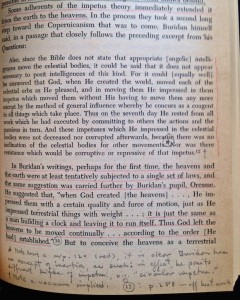The last two posts come together in this quick note. Again, digging through boxes of books, I came across the academic’s copy of Thomas Kuhn’s The Coperncian Revolution (I’m confident he owned a copy of Structure, I just haven’t found it yet). As his characteristic signature indicates on the title page, he purchased his pocket, paperback edition in 1960.

And as is typical, he read carefully with pencil and red pencil and at some point pen and later pencil in hand. For example, on page 121 he underlined passages in pencil, both red and black. He added notes in the bottom margin, keyed to interlinear symbols he had added to the text. And he commented on the value of works Kuhn cited.

Across the bottom we read:
* Note have a m/p. 120 (red), it is clear Buridan has no concept of inertia, as such: in effect, he posits different kinds of impetus, e.g., “circular impetus.”
† Note a vacuum implied. 13: p.280—off beat work
Page 120 was generously underlined, so to help him identify the relevant section, he noted that he was referring to the passage underlined in red. It is unclear whether he underlined the passage in red so that he could refer to it on page 121 or if he had chosen red for some other reason and was now able to select that section. In either case, it gestures to his meticulous and intentional reading habits.
He returned to this book at least one more time. In 1967 he added a note to a diagram wondering if the mechanism it illustrated “had been added to take care of precession of the equinoxes.” Uncharacteristically, he did not record his decision on that issue.